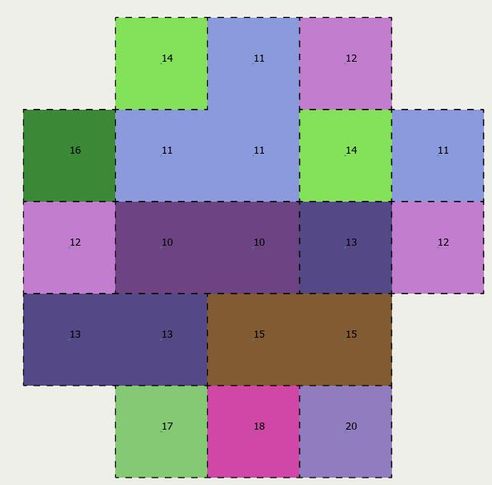- Home
- :
- All Communities
- :
- Products
- :
- ArcGIS Pro
- :
- ArcGIS Pro Questions
- :
- Raster to Polygon Simplify Polygons option not wor...
- Subscribe to RSS Feed
- Mark Topic as New
- Mark Topic as Read
- Float this Topic for Current User
- Bookmark
- Subscribe
- Mute
- Printer Friendly Page
Raster to Polygon Simplify Polygons option not working as expected
- Mark as New
- Bookmark
- Subscribe
- Mute
- Subscribe to RSS Feed
- Permalink
Hi. I am running the Raster to Polygon tool with the Simplify Polygons option off (unchecked).
I expect (and my ultimate goal is) to get a polygon version of the raster where the polygon boundaries match the raster cell 'boundaries' exactly (e.g. 20x 20 metre cell boundary).
However, when adjacent cells have the same value, the resulting polygon is a merged polygon. See the pic for a visual where the resulting poly feature class is the dashed lines and the raster grid values are indicated.
Do the polygons merge because the input raster requires unique values? If so, any ideas on how to make each cell unique, but maintain the original grid cell value?
Thanks.
ArcGIS Pro 2.6.1
ArcGIS Desktop 10.6.1
Solved! Go to Solution.
Accepted Solutions
- Mark as New
- Bookmark
- Subscribe
- Mute
- Subscribe to RSS Feed
- Permalink
Thanks for the prompt responses.
The fishnet solution and split polygon is something I considered, but the size and complexity of the data pushed me away from this.
However, the split polygon method made me search for similar tools and I found Subdivide Polygon.
This tool gave me the option to split the polygons into equal area of a target size and control the angle (both important for my analysis). Stacked blocks option also produced the better results in my case.
Although imperfect, this method appears to have outputted a feature class appropriate for my analysis.
- Mark as New
- Bookmark
- Subscribe
- Mute
- Subscribe to RSS Feed
- Permalink
If the data isn't too big/complex, the fastest way would be to use "Split Polygon" from editing menu, with snapping on at end-points.
Creating Fishnet would be another option (with 20X20 meter cell dimension).
Think Location
- Mark as New
- Bookmark
- Subscribe
- Mute
- Subscribe to RSS Feed
- Permalink
The Raster to Polygon tool is built with merging identical cell values in mind.
You might try instead creating a polygon fishnet, aligning the grid size and origin w/ the raster. Then using the fishnet layer as your zones, run Zonal Statistics.
Kendall County GIS
- Mark as New
- Bookmark
- Subscribe
- Mute
- Subscribe to RSS Feed
- Permalink
Thanks for the prompt responses.
The fishnet solution and split polygon is something I considered, but the size and complexity of the data pushed me away from this.
However, the split polygon method made me search for similar tools and I found Subdivide Polygon.
This tool gave me the option to split the polygons into equal area of a target size and control the angle (both important for my analysis). Stacked blocks option also produced the better results in my case.
Although imperfect, this method appears to have outputted a feature class appropriate for my analysis.
